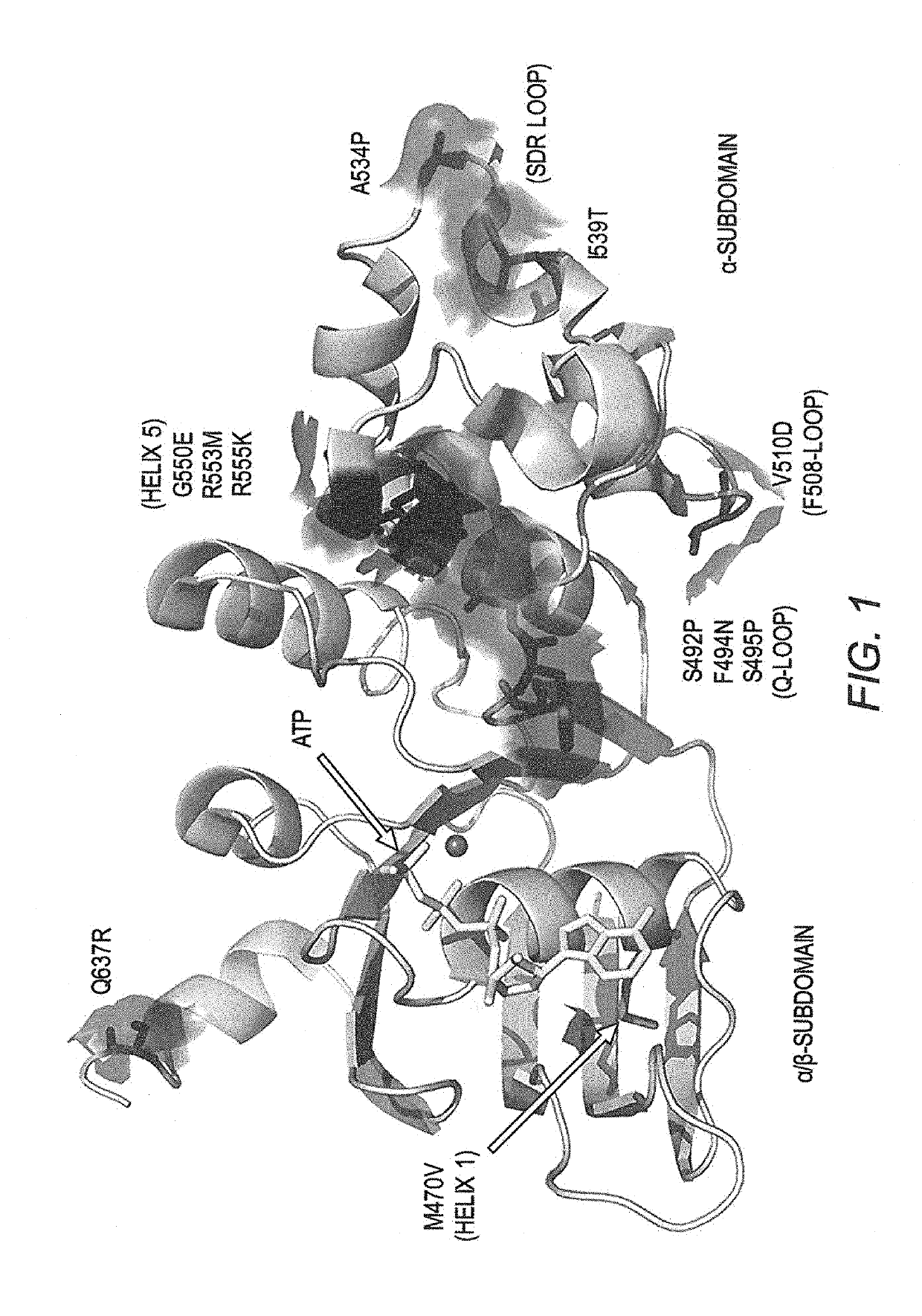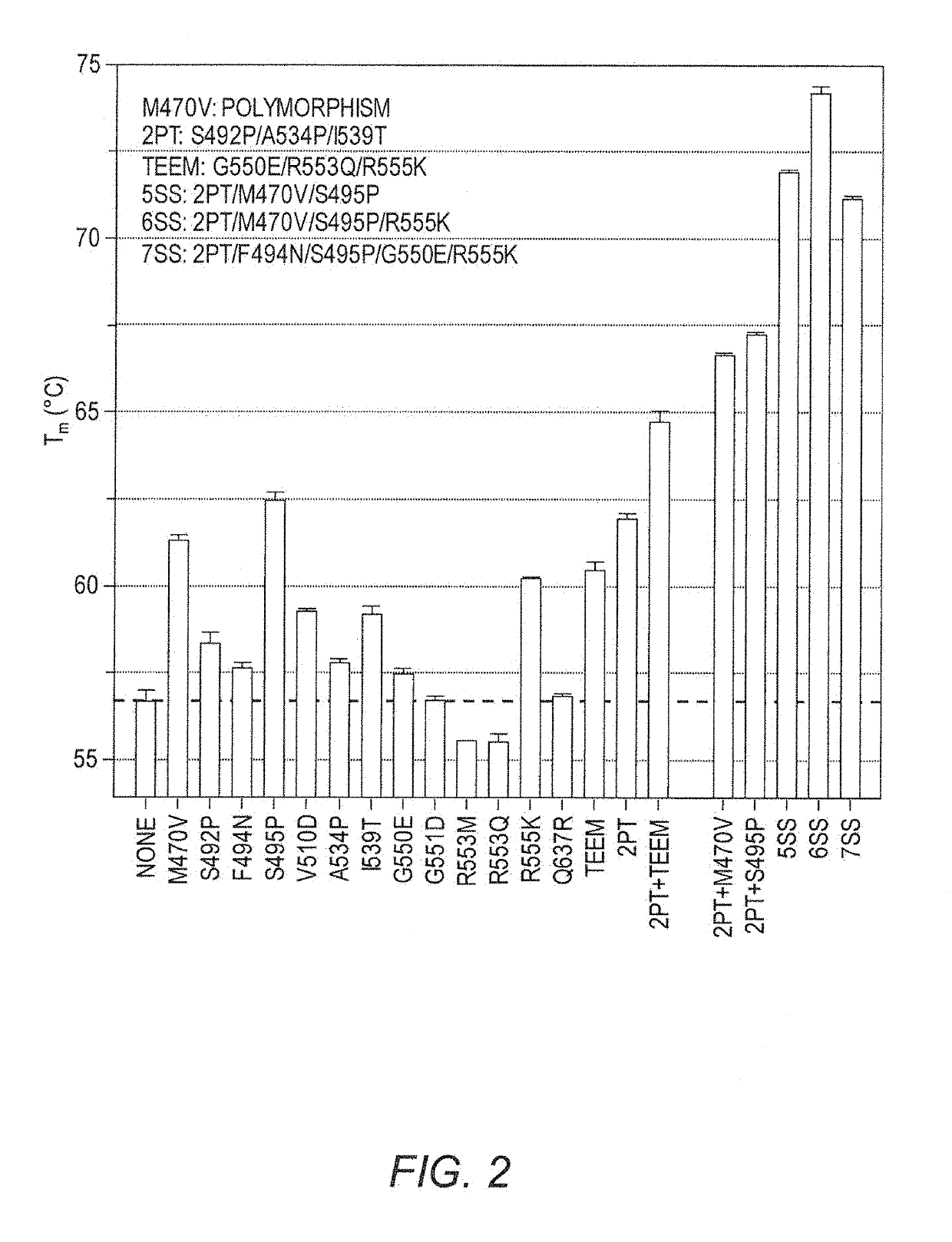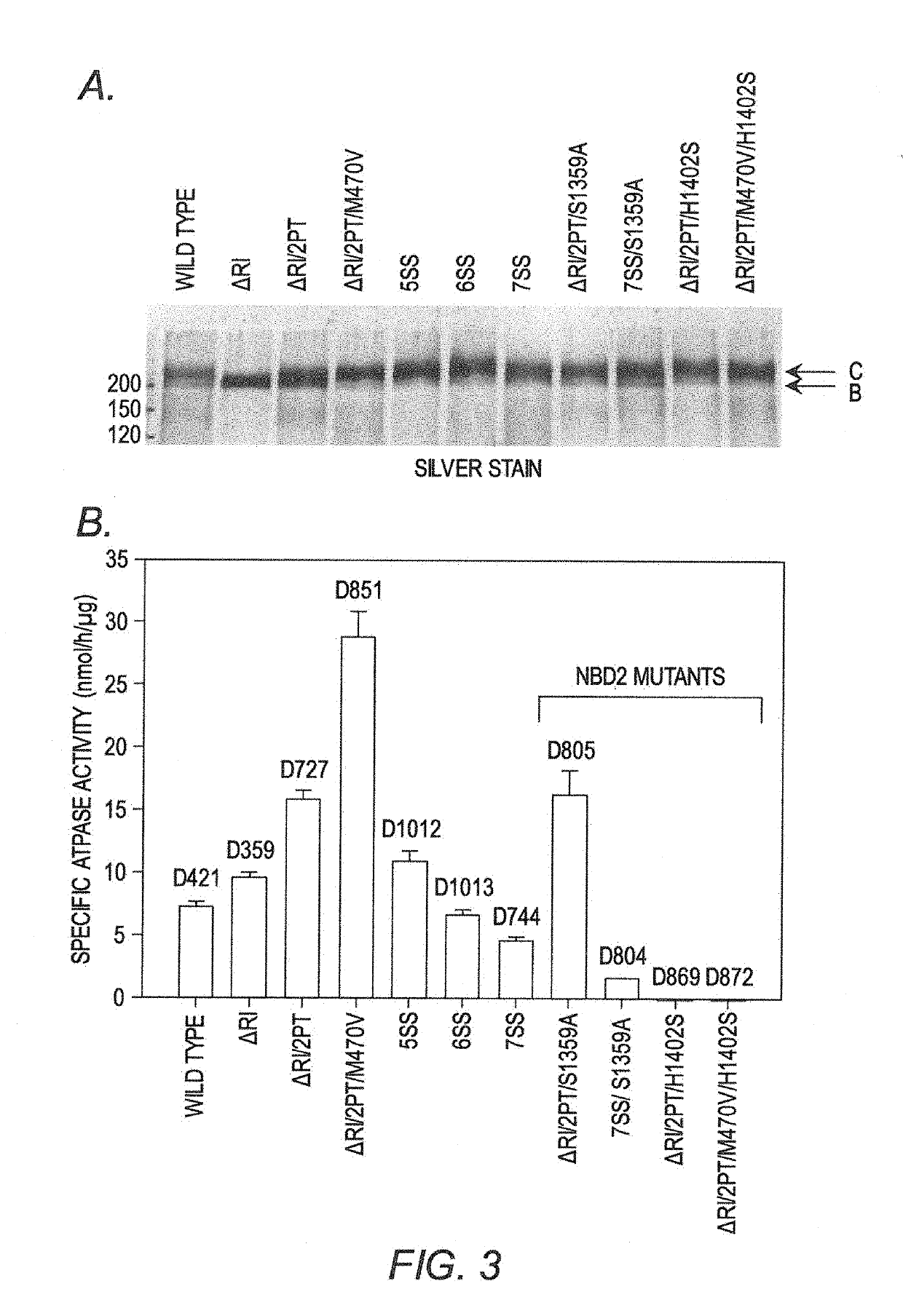Modified cystic fibrosis transmembrane conductance regulator (CFTR) polypeptides with increased stability and uses thereof
a transmembrane conductance regulator and polypeptide technology, applied in the direction of peptides, peptide sources, instruments, etc., can solve the problems of inability of this mutant protein to exit the er, traffic to the plasma membrane, and no cure, and achieve the effect of increasing the structural stability of the polypeptid
- Summary
- Abstract
- Description
- Claims
- Application Information
AI Technical Summary
Benefits of technology
Problems solved by technology
Method used
Image
Examples
example 1
tudies of NBD1 and Full Length CFTR
[0112]NBD1 purification. CFTR NBD1 (residues 387-646, Δ1405-436D containing the wild type sequence with the M470 polymorphism, referred herein as ΔRI-NBD1, was expressed in E. coli, and the protein purified in 150 mM NaCl, 20 mM HEPES pH 7.5, 10% glycerol, 10% ethylene glycol, 1 mM tris-(2-carboxymethyl) phosphine, 2 mM ATP, 3 mM MgCl2 as previously described (S. Atwell, et al., Protein Eng. Des Sel, 23 (2010) 375-384; C. Wang, et al., Protein Sci, 19 (2010) 1932-1947; I. Protasevich, et al., Protein Sci, 19 (2010) 1917-1931; Z. Yang, et al., Protein Sci, 23 (2014) 769-789). Proteins were >98% pure as judged by Coomassie Blue staining of SDS-PAGE gels (FIG. 9), showed no evidence of aggregation and ran as monomers during gel filtration. Protein concentration was determined with the Pierce BCA 660 nm assay in microtiter plate format, using Bacillus subtilis NAD synthetase as a standard. Proteins were stored at −80° C.
[0113]Differential scanning calo...
example 2
ilization by Mutagenesis
[0123]FIG. 1 shows the locations of the known NBD1 stabilizing mutations (L. He, et al., J Mol Biol, 427 (2015) 106-120; L. He, et al., FASEB J, 24 (2010) 3103-3112; A. A. Aleksandrov, et al., J Mol Biol, 419 (2012) 41-60; L. He, et al., J Mol Biol, 427 (2015) 106-120; H. A. Lewis, et al., J Biol Chem, 280 (2005) 1346-1353; J. L. Teem, et al., Receptors Channels, 4 (1996) 63-72; J. L. Teem, et al., Cell, 73 (1993) 335-346; A. C. DeCarvalho, et al., J Biol Chem, 277 (2002) 35896-35905). Most of these known mutations are located in the α-subdomain. As we will show, M470V located in the first helix in the α / β-subdomain (FIG. 1) is also a stabilizing mutation. The M470 polymorphism is nearly always present with the F508 mutation, compared to 50% concurrence of either M or V alleles with WT CFTR (B. M. Ciminelli, et al., J Cyst Fibros, 6 (2007) 15-22). M470-CFTR protein reportedly matures more slowly, and exhibits a 1.7-fold increased intrinsic chloride channel ac...
example 3
D1 Mutations Increase Calorimetric Tm
[0124]We have previously applied DSC to investigate the thermodynamics and kinetics of unfolding of isolated NBD1 proteins (I. Protasevich, et al., Protein Sci, 19 (2010) 1917-1931; Z. Yang, et al., Protein Sci, 23 (2014) 769-789; Z. Yang, et al., Methods Enzymol, 567 (2016) 319-358). Here we have determined the calorimetric unfolding temperature (Tmcal) of individual mutations in the isolated NBD1 domain, then assessed the effects of multiple NBD1 mutations (FIG. 2). We used the WT human NBD1 carrying a deletion of the 32 amino acid regulatory insertion (ΔRI-NBD1, Δ405-436) which is not present in other ABC transporters (S. Atwell, et al., Protein Eng Des Sel, 23 (2010) 375-384). ΔRI-NBD1 shows favorable solution properties and enabled the structure determinations of WT and ΔF508-NBD1 (S. Atwell, et al., Protein Eng Des Sel, 23 (2010) 375-384). We found that the M470V mutation (V470 polymorphism) strongly stabilized ΔRI-NBD1 (Tm of 56.7±0.3° C.,...
PUM
| Property | Measurement | Unit |
|---|---|---|
| Temperature | aaaaa | aaaaa |
| Temperature | aaaaa | aaaaa |
| Temperature | aaaaa | aaaaa |
Abstract
Description
Claims
Application Information
 Login to View More
Login to View More - R&D
- Intellectual Property
- Life Sciences
- Materials
- Tech Scout
- Unparalleled Data Quality
- Higher Quality Content
- 60% Fewer Hallucinations
Browse by: Latest US Patents, China's latest patents, Technical Efficacy Thesaurus, Application Domain, Technology Topic, Popular Technical Reports.
© 2025 PatSnap. All rights reserved.Legal|Privacy policy|Modern Slavery Act Transparency Statement|Sitemap|About US| Contact US: help@patsnap.com



